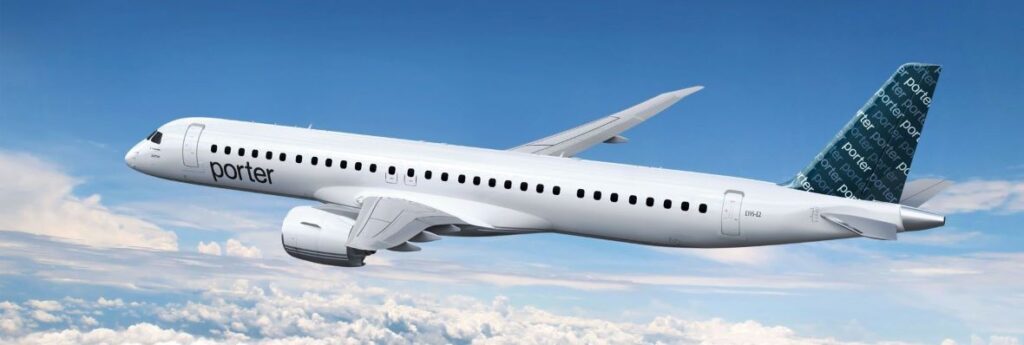When Porter Airlines resumes operations on Sept. 8 after an 18-month pandemic pause, it plans to do so with a bang, not a whimper. The Toronto-based airline says it will spend billions to introduce up to 80 state-of-the-art Embraer E195-E2 aircraft into its fleet starting in the second half of 2022. Significantly, the planes have transcontinental range, which will enable Porter to reach potential markets coast to coast in Canada, along with destinations in the US, Mexico, and the Caribbean.
Porter is Embraer’s North American launch customer for the E2 with the total aircraft order valued at up to US$5.82 billion for 30 firm commitments and 50 purchase right options.
The agreement also includes the ability to convert purchase rights to smaller E190-E2, which would provide opportunities to introduce non-stop service in markets where connecting flights are often the only option today, as well as enabling higher-frequency service for routes with greater demand.
Porter intends to operate the E2s to popular destinations from Ottawa, Montreal, Halifax, and Toronto Pearson International Airport, with specific routes to be determined in advance of aircraft deliveries.
“We believe that now is the right time to make this investment as the pandemic resets the aviation landscape,” says Porter president and CEO Michael Deluce. “Adding a diverse selection of popular business and leisure destinations to our network means that we are better positioned to serve the needs of many more passengers.”
Despite establishing service from Pearson Airport for the first time, flights from Porter’s existing hub at downtown Toronto’s Billy Bishop Airport will remain core to its business and will continue with high-frequency regional service on turboprop aircraft. Service is confirmed to restart at Billy Bishop on Sept. 8, following a temporary shutdown due to the COVID-19 pandemic and associated travel restrictions.
Porter maintains that the Toronto island airport is essential to its immediate plans for re-establishing flights and developing future routes and that it will not operate E2s from there.
“Our commitment to Billy Bishop Airport is not changing,” says Robert Deluce, Porter’s founder and executive chairman. “Our corporate headquarters at Billy Bishop is being maintained and we will continue serving the same network of regional markets from downtown Toronto.”
He adds, “We are moving beyond this existing footprint to welcome more travellers across North America.”
Belonging to the most environmentally friendly single-aisle aircraft family, measured by sound and CO2 emissions, the E195-E2 is 65% quieter than previous generation types.
The aircraft accommodates between 120 and 146 passengers and fits Porter’s traditional service offering, with a passenger-focused design with an aisle or window seating for every passenger, large windows and overhead bins, and cabin mood lighting.

The airline is currently finalizing its preferred configuration and additional passenger experience details, such as in-flight entertainment and onboard service.
Combined with Porter’s existing De Havilland Dash 8-400s, Porter says it will have one of the world’s most environmentally sustainable commercial aircraft fleets. Funds for the purchase are being raised privately from shareholders, as well as through aircraft sale-leaseback agreements.
Airline analyst Robert Kokonis, president of airline consulting firm AirTrav Inc., says Porter’s expansion is a “bold move” that will surely illicit a strong response from Canada’s two largest airlines, especially as it prepares to land “in the jaws of the dragon at Pearson, which is Air Canada’s main base of operations and the second-largest base for WestJet Airlines.
“WestJet and Air Canada are not going to take this sitting down,” he says, adding, “They’re going to put a very robust response on the marketplace because everybody’s suffered through the pandemic.”
But Kokonis doesn’t believe Porter will try to become Sunwing, Transat, or Air Canada Rouge by appealing mainly to the leisure crowd. Instead, he expects it will continue to cater to business travellers who have taken advantage of the Toronto island airport’s quick access to the country’s largest city, in addition to leisure travellers.
Porter’s growth has always been limited by available slots at the island airport. Its effort to add jet service was quashed in 2015 when jets were barred.
The airline placed a conditional order in 2013 for Bombardier CSeries planes, now known as Airbus A220, but let that order lapse within the past year and switched to Embraer’s latest product after reviewing its expansion plans.
Kokonis says the Embraer plane is a great option for Porter, which has an extremely strong brand presence and customer base in Eastern Canada.
He adds: “It’s a very, very bold and decisive market action they’re taking… And I think they might just have a fighting chance to make it all work.”
Porter currently offers flights to Toronto, Ottawa, Montreal, Quebec City, Fredericton, Saint John, Moncton, Halifax, St. John’s, Thunder Bay, Sault Ste. Marie, Sudbury, Timmins, Windsor, New York (Newark), Chicago (Midway), Boston and Washington (Dulles), and has seasonal flights to Mt. Tremblant, Que., Muskoka, Ont., Myrtle Beach, S.C., and Stephenville, N.L.

